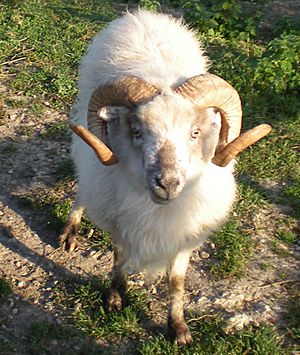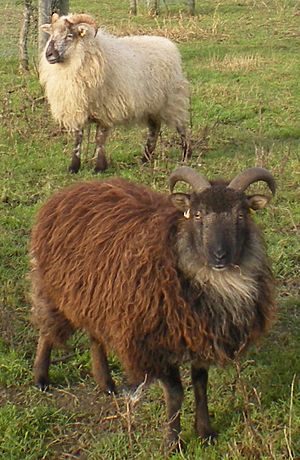Boreray sheep facts for kids

A Boreray ram.
|
|
| Conservation status |
|
|---|---|
| Country of origin | Scotland |
| Distribution | Scotland |
| Use | Conservation Grazing, Meat, Wool |
| Traits | |
| Weight |
|
| Height |
|
| Horn status | Horned |
|
|

The Boreray is a special type of sheep. It comes from a group of islands called St Kilda in Scotland. These sheep live wild, or feral, on one of the islands, Boreray.
People used to raise Boreray sheep for their meat and wool. Today, they are mostly used for something called conservation grazing. This means they help protect natural areas by eating plants. The Boreray sheep belongs to a group known as Northern European short-tailed sheep.
This breed is one of the rarest sheep in the United Kingdom. The Rare Breeds Survival Trust lists them as "Category 3: Vulnerable." This means there are between 500 and 900 breeding female sheep (ewes) left. Not long ago, they were in an even more critical group, but their numbers have grown!
Contents
St Kilda's Unique Sheep Breeds
St Kilda is a far-off group of islands located west of the Outer Hebrides. Several kinds of sheep have lived on St Kilda over time.
Besides the Boreray, there's also the Soay sheep. These are wild sheep from Soay, another island in the St Kilda group. You might also hear about the Hebridean sheep. This breed used to be called the "St Kilda sheep," but it probably didn't actually come from St Kilda itself.
A Look Back: Boreray Sheep History
For a long time, until the late 1700s, most domesticated sheep in the Scottish Highlands and Islands were a type called the Scottish Dunface. This sheep was likely similar to sheep kept across northern Europe during the Iron Age.
On the St Kilda islands of Boreray and Hirta, the local farmers, called crofters, kept a special kind of Dunface sheep. These crofters lived on Hirta, the biggest island. Today, the Boreray, along with the North Ronaldsay and Shetland breeds, are descendants of the old Dunface sheep.
In the mid-1700s, these crofters' sheep were described as very small. They had short, rough wool. All of them had horns, usually one pair, but sometimes two! At that time, there were about 1,000 of these sheep on Hirta and 400 on Boreray.
Later, in the late 1800s, the crofters' sheep were mixed with Scottish Blackface sheep. These Blackface sheep had become very common across mainland Scotland.
Before the people of St Kilda left in 1930, they farmed these sheep. But when the islanders were evacuated, the sheep on Hirta were also moved. In 1932, Soay sheep were brought to Hirta, and they still live there today.
The sheep left on Boreray became wild, or feral. These wild sheep became the only survivors of the crofters' original sheep. They are also one of the few remaining types of the old Dunface sheep. This means they are the original sheep that used to be farmed on the island, without being changed. In the 1970s, a few Boreray sheep were taken to the mainland to start new flocks. But most Borerays still live wild on their home island.
What Makes Boreray Sheep Special?

Even though they have some Scottish Blackface in them (which is a long-tailed breed), Boreray sheep share features with other northern European short-tailed sheep. They are among the smallest sheep breeds. Adult female sheep, called ewes, weigh about 28 kilograms (62 pounds). They stand about 55 centimeters (22 inches) tall at their shoulders, which is called the withers.
Unique Features
Boreray sheep have naturally short tails. This means they don't need their tails shortened, a process called docking. They also naturally shed their fleece every year. This is called moulting, so they don't usually need to be shorn by people. However, older sheep might need a little help shedding their wool.
Their wool is usually grey or creamy white on their bodies. Some Boreray sheep can be darker, similar to the Soay sheep. The wool is quite rough. It's mostly used to make tweeds or carpet yarns. Tweed is a thick, rough fabric often made in Scotland, known for its mixed, flecked colors. The sheep's face and legs have no wool and are black and white. The amount of black and white varies from sheep to sheep.
Both male and female Boreray sheep have horns. In the past, some had more than one pair, but now they always have just one pair. The horns on the ewes are usually thinner and curve, but they don't spiral around more than once. Male sheep, called rams, can grow very large, spiral horns. These impressive horns can even be used to make crafts, like the curved tops of shepherd's crooks. Farmers who raise Boreray sheep describe the rams' horns as "striking and majestic."
How Many Boreray Sheep Are There?
In 1999, there were thought to be fewer than 84 Boreray sheep, with only 74 ewes. By 2002, the number grew to between 92 and 100 animals, with 92 ewes. In 2012, 204 ewes were officially recorded in special books called herdbooks.
Since 2012, the number of Boreray sheep has been growing each year. In 2017, the Rare Breeds Survival Trust changed their classification from 'Category 2: Critical' to 'Category 3: Vulnerable'. This happened because the number of breeding ewes was estimated to be over 500. This information comes from the herdbooks, which list all registered sheep. The numbers are then adjusted to include sheep that aren't officially registered.
However, in 2017, the United Nations Food and Agriculture Organisation (FAO) estimated a slightly different number: 426 breeding ewes.
Why Are Boreray Sheep Farmed Today?
These sheep were originally raised for their meat and wool. But because they are so rare now, they are mostly raised for conservation purposes. This means they help protect nature. Most Boreray sheep are thought to be wild, not farmed.
Because they grew up in tough conditions, Boreray sheep are great for conservation grazing. This is when livestock, like sheep, are used to help improve the variety of plants and animals in a natural area. The Rare Breeds Survival Trust believes that Boreray sheep could be even more useful for this if their breed is developed further.
Images for kids


